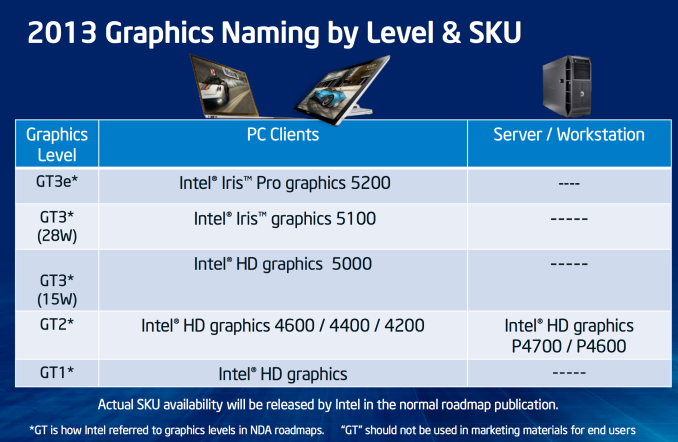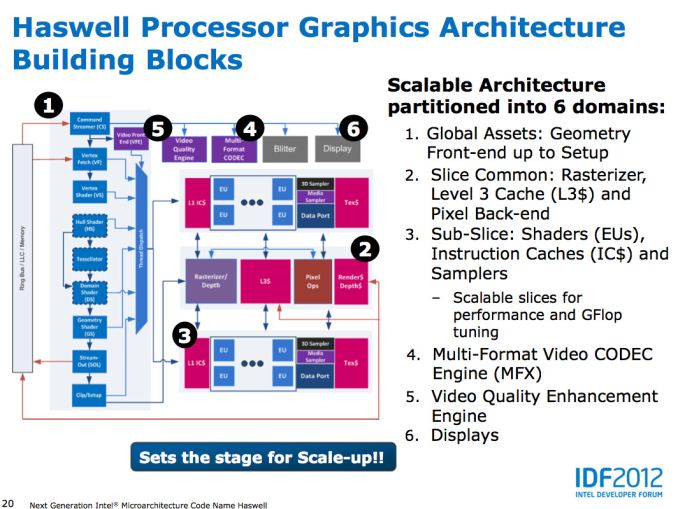Intel Iris Pro 5200 Graphics Review: Core i7-4950HQ Tested
by Anand Lal Shimpi on June 1, 2013 10:01 AM ESTHaswell GPU Architecture & Iris Pro
In 2010, Intel’s Clarkdale and Arrandale CPUs dropped the GMA (Graphics Media Accelerator) label from its integrated graphics. From that point on, all Intel graphics would be known as Intel HD graphics. With certain versions of Haswell, Intel once again parts ways with its old brand and introduces a new one, this time the change is much more significant.
Intel attempted to simplify the naming confusion with this slide:
While Sandy and Ivy Bridge featured two different GPU implementations (GT1 and GT2), Haswell adds a third (GT3).
Basically it boils down to this. Haswell GT1 is just called Intel HD Graphics, Haswell GT2 is HD 4200/4400/4600. Haswell GT3 at or below 1.1GHz is called HD 5000. Haswell GT3 capable of hitting 1.3GHz is called Iris 5100, and finally Haswell GT3e (GT3 + embedded DRAM) is called Iris Pro 5200.
The fundamental GPU architecture hasn’t changed much between Ivy Bridge and Haswell. There are some enhancements, but for the most part what we’re looking at here is a dramatic increase in the amount of die area allocated for graphics.
All GPU vendors have some fundamental building block they scale up/down to hit various performance/power/price targets. AMD calls theirs a Compute Unit, NVIDIA’s is known as an SMX, and Intel’s is called a sub-slice.
In Haswell, each graphics sub-slice features 10 EUs. Each EU is a dual-issue SIMD machine with two 4-wide vector ALUs:
| Low Level Architecture Comparison | ||||||||||||||||
| AMD GCN | Intel Gen7 Graphics | NVIDIA Kepler | ||||||||||||||
| Building Block | GCN Compute Unit | Sub-Slice | Kepler SMX | |||||||||||||
| Shader Building Block | 16-wide Vector SIMD | 2 x 4-wide Vector SIMD | 32-wide Vector SIMD | |||||||||||||
| Smallest Implementation | 4 SIMDs | 10 SIMDs | 6 SIMDs | |||||||||||||
| Smallest Implementation (ALUs) | 64 | 80 | 192 | |||||||||||||
There are limitations as to what can be co-issued down each EU’s pair of pipes. Intel addressed many of the co-issue limitations last generation with Ivy Bridge, but there are still some that remain.
Architecturally, this makes Intel’s Gen7 graphics core a bit odd compared to AMD’s GCN and NVIDIA’s Kepler, both of which feature much wider SIMD arrays without any co-issue requirements. The smallest sub-slice in Haswell however delivers a competitive number of ALUs to AMD and NVIDIA implementations.
Intel had a decent building block with Ivy Bridge, but it chose not to scale it up as far as it would go. With Haswell that changes. In its highest performing configuration, Haswell implements four sub-slices or 40 EUs. Doing the math reveals a very competent looking part on paper:
| Peak Theoretical GPU Performance | ||||||||||||||||
| Cores/EUs | Peak FP ops per Core/EU | Max GPU Frequency | Peak GFLOPs | |||||||||||||
| Intel Iris Pro 5100/5200 | 40 | 16 | 1300MHz | 832 GFLOPS | ||||||||||||
| Intel HD Graphics 5000 | 40 | 16 | 1100MHz | 704 GFLOPS | ||||||||||||
| NVIDIA GeForce GT 650M | 384 | 2 | 900MHz | 691.2 GFLOPS | ||||||||||||
| Intel HD Graphics 4600 | 20 | 16 | 1350MHz | 432 GFLOPS | ||||||||||||
| Intel HD Graphics 4000 | 16 | 16 | 1150MHz | 294.4 GFLOPS | ||||||||||||
| Intel HD Graphics 3000 | 12 | 12 | 1350MHz | 194.4 GFLOPS | ||||||||||||
| Intel HD Graphics 2000 | 6 | 12 | 1350MHz | 97.2 GFLOPS | ||||||||||||
| Apple A6X | 32 | 8 | 300MHz | 76.8 GFLOPS | ||||||||||||
In its highest end configuration, Iris has more raw compute power than a GeForce GT 650M - and even more than a GeForce GT 750M. Now we’re comparing across architectures here so this won’t necessarily translate into a performance advantage in games, but the takeaway is that with HD 5000, Iris 5100 and Iris Pro 5200 Intel is finally walking the walk of a GPU company.
Peak theoretical performance falls off steeply as soon as you start looking at the GT2 and GT1 implementations. With 1/4 - 1/2 of the execution resources as the GT3 graphics implementation, and no corresponding increase in frequency to offset the loss the slower parts are substantially less capable. The good news is that Haswell GT2 (HD 4600) is at least more capable than Ivy Bridge GT2 (HD 4000).
Taking a step back and looking at the rest of the theoretical numbers gives us a more well rounded look at Intel’s graphics architectures :
| Peak Theoretical GPU Performance | ||||||||||||||||
| Peak Pixel Fill Rate | Peak Texel Rate | Peak Polygon Rate | Peak GFLOPs | |||||||||||||
| Intel Iris Pro 5100/5200 | 10.4 GPixels/s | 20.8 GTexels/s | 650 MPolys/s | 832 GFLOPS | ||||||||||||
| Intel HD Graphics 5000 | 8.8 GPixels/s | 17.6 GTexels/s | 550 MPolys/s | 704 GFLOPS | ||||||||||||
| NVIDIA GeForce GT 650M | 14.4 GPixels/s | 28.8 GTexels/s | 900 MPolys/s | 691.2 GFLOPS | ||||||||||||
| Intel HD Graphics 4600 | 5.4 GPixels/s | 10.8 GTexels/s | 675 MPolys/s | 432 GFLOPS | ||||||||||||
| AMD Radeon HD 7660D (Desktop Trinity, A10-5800K) | 6.4 GPixels/s | 19.2 GTexels/s | 800 MPolys/s | 614 GFLOPS | ||||||||||||
| AMD Radeon HD 7660G (Mobile Trinity, A10-4600M) | 3.97 GPixels/s | 11.9 GTexels/s | 496 MPolys/s | 380 GFLOPS | ||||||||||||
Intel may have more raw compute, but NVIDIA invested more everywhere else in the pipeline. Triangle, texturing and pixel throughput capabilities are all higher on the 650M than on Iris Pro 5200. Compared to AMD's Trinity however, Intel has a big advantage.












177 Comments
View All Comments
jasonelmore - Sunday, June 2, 2013 - link
Looking at the prices, this will raise the price or Lower the margins of the 13" Retina Macbook Pro by about $150 each.mschira - Sunday, June 2, 2013 - link
Yea laptops benefit most - good for them.But what about the workstation?
So intel stopped being a CPU company and turned into a mediocre GPU company? (can even beat last years GT650M)
I would applaude the rise in GPU performance if they had not completely forgotten the CPU.
M.
n13L5 - Monday, June 3, 2013 - link
You're exactly right.13" ultrabook buyers who need it the most get little to nothing out of this.
And desktop users don't need or want GT3e and it uses system RAM. Better off buying a graphics card instead of upgrading to Haswell on desktops.
glugglug - Tuesday, June 4, 2013 - link
While I agree this misses "where it would benefit most", I disagree on just *where* that is.I guess Intel agrees with Microsofts implicit decision that media center is dead. Real-time HQ quicksync would be perfect to transcode anything extenders couldn't handle, and would also make the scanning for and skipping of commercials incredibly efficient.
n13L5 - Tuesday, June 11, 2013 - link
Core i5…4350U…Iris 5000…15W…1.5 GHzCore i7…4550U…Iris 5000…15W…1.5 GHz
Core i7…4650U…Iris 5000…15W…1.7 GHz
These should work. The 4650U is available in the Sony Duo 13 as we speak, though at a hefty price tag of $1,969
Eric S - Monday, July 1, 2013 - link
The last 13" looks like they were prepping it for a fusion drive then changed their mind leaving extra space in the enclosure. I think it is due for an internal redesign that could allow for a higher wattage processor.I think the big deal is the OpenCL performance paired with ECC memory for the GPU. The Nvidia discrete processor uses non-ECC GDDR. This will be a big deal for users of Adobe products. Among other things, this solves the issue of using the Adobe mercury engine with non-ECC memory and the resulting single byte errors in the output. The errors are not a big deal for games, but may not be ideal for rendering professional output and scientific applications. This is basically a mobile AMD FireGL or Nvidia Quadro card. Now we just need OpenCL support for the currently CUDA-based mercury engines in After Effects and Premiere. I have a feeling that is coming or Adobe will also lose Mercury Engine compatibility with the new Mac Pro.
tviceman - Saturday, June 1, 2013 - link
Impressive iGPU performance, but I knew Intel was absolutely full of sh!t when claiming equal to or better than GT 650m performance. Not really even close, typically behind by 30-50% across the board.Krysto - Saturday, June 1, 2013 - link
When isn't Intel full of shit? Always take what the improvements they claim and cut it in half, and you'll be a lot closer to reality.xtc-604 - Saturday, June 8, 2013 - link
Lol...you think that's bad? Look at Apple's claims. "over 200 new improvements in Mountain Lion"piroroadkill - Saturday, June 1, 2013 - link
sh<exclamation point>t? What are we? 9?